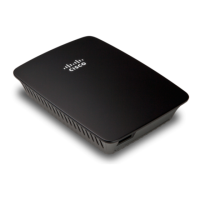3
Wireless-N Extender
Linksys RE1000 Chapter 2: Advanced Configuration
Chapter 2: Advanced Configuration
After setting up the Extender with the setup software
(located on the CD-ROM), the Extender will be ready for
use. If you would like to change its advanced settings,
use the Extender’s browser-based utility. This chapter
describes each web page of the utility and each page’s key
functions. You can access the utility via a web browser on
a computer connected to the Extender.
How to Access the Browser-Based Utility
To access the browser-based utility, launch the web
browser on your computer, and enter the Extender’s
default Internet Protocol (IP) address, 192.168.1.1, in the
Address field. Then press Enter. This works only if your
Extender has not been configured. If your Extender has
been configured, log into your access point or router User
Interface, look for the status page, locate the DHCP table
using the user manual of your access point or router, and
look for RE1000 in the DHCP table. The IP address should
show up , make a note of it , and then enter it in your web
browser link address. Then press Enter
NOTE: You can also access the browser-based
utility on Windows computers by looking up
the UPnP network devices. Double click on the
RE1000 icon.
A login screen appears. (A similar screen appears for
non-Windows 7 users.)
Login Screen
1. In the User name field, enter admin.
2. In the Password field, enter the password created
by the setup software. If you did not run the setup
software, then enter the default, admin.
NOTE: You can set a new password on the
Administration > Management screen. Refer to
“Administration > Management” on page 40.
3. Click OK to continue.
NOTE: You can also access the browser-based
utility through Cisco Connect.
How to Use the Browser-Based Utility
Use the tabs at the top of each screen to navigate within
the utility. The tabs are arranged in two levels, top-level
tabs for general functions and lower-level tabs for the
corresponding specific functions.
Top- and Lower-Level Tabs
The top-level tabs are: Setup, Wireless, Security,
Administration, and Status. Each of these has its own
unique, lower-level tabs.
NOTE: Within this User Guide, each screen is
identified by its top- and lower-level tab names.
For example, “Setup > Basic Setup” is the screen
accessed via the Setup top-level tab, and its
Basic Setup lower-level tab.
If you change any settings on a screen, you must click Save
Settings to apply your changes, or click Cancel Changes
to clear your changes. These controls are located at the
bottom of each screen.
Save Settings or Cancel Settings
Click Help on the right side of a screen for additional
information on the screen’s options.

